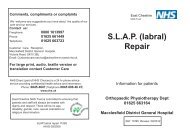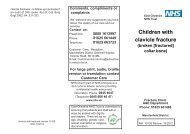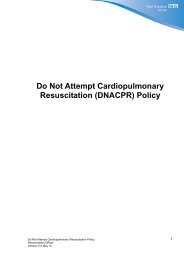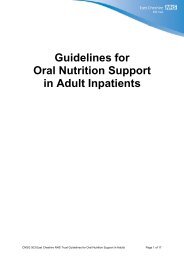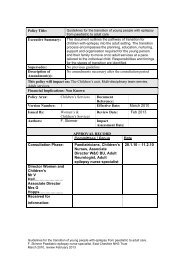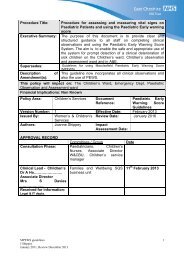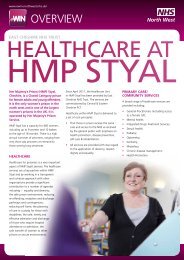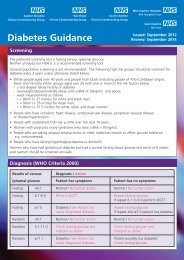Post death procedure - East Cheshire NHS Trust
Post death procedure - East Cheshire NHS Trust
Post death procedure - East Cheshire NHS Trust
Create successful ePaper yourself
Turn your PDF publications into a flip-book with our unique Google optimized e-Paper software.
SECTION SEVEN – MORTUARY DEPARTMENTCONGLETON WAR MEMORIAL HOSPITAL (Aston Ward) and KNUTSFORD &DISTRICT COMMUNITY HOSPITAL (Tatton Ward): Local <strong>procedure</strong>s are in force, pleasecontact the wards directly.MACCLESFIELD DISTRICT GENERAL HOSPITAL: This department is provided to allow: Temporary storage of deceased patients prior to removal by funeral directors <strong>Post</strong>-mortem examinations to be carried out at the request of relatives or HM Coroner Viewing of deceased patients by their partner or relativesHOURS: The department is routinely staffed from:8 am - 4.30 pm Monday to Friday. Outside these times the technicians are available toprovide advice and assistance on an on-call basis (contact via the hospital switchboard).VIEWING DECEASED PATIENTS BY RELATIVES:During normal working hours contact the mortuary direct (tel ext 1847) to arrange anappointment.Out of hours viewing are arranged via the bed managers, however if additional assistance isrequired contact the technician on call.RELEASE OF BODIES:This will only be permitted when all documents have been completed and, in cases ofsudden <strong>death</strong>, where there is no need for the involvement of HM Coroner.Bodies will only be released to funeral directors and this must take place via mortuary.For releases out of hours the Bed Manager/Night Sisters must ensure that all relevantdocumentation is available and signed (see Release of Bodies Out of Hours protocol - seepink pages following this section). The Bed Manager/Night Sisters must contact themortuary technician on-call and request that they attend to supervise the release <strong>procedure</strong>.POST-MORTEM EXAMINATIONS:These are ALWAYS carried out in a respectful manner and with regard for the feelings ofbereaved relatives. The standards used during the examination are those set by the RoyalCollege of Pathologists.Initially the pathologist carries out a careful examination of the body. Photographs and X-rays are sometimes taken for more detailed study. The internal part of the examination thenbegins. An incision is made down the front of the body and internal organs are removed for adetailed examination. If the brain is to be examined an incision is made in the hair at thebase of the head. If the examination requires particular body parts or organs to be kept forsome time in the case of hospital post-mortems, partners or relatives will be asked for writtenagreement to this.With Coroner post-mortems consent is provided by HM Coroner whose officer will informrelatives of the need for such removal and obtain signed consent from the relativesregarding their wishes for subsequent disposal of these organs.Benefits Of A <strong>Post</strong>-Mortem Examination:22/34





